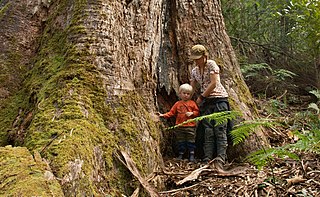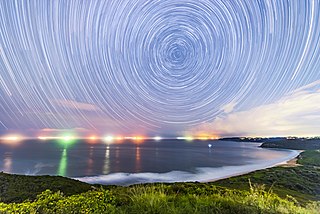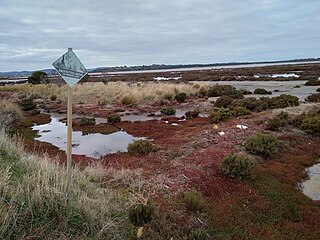Related Research Articles

Protected areas of Australia include Commonwealth and off-shore protected areas managed by the Australian government, as well as protected areas within each of the six states of Australia and two self-governing territories, the Australian Capital Territory and the Northern Territory, which are managed by the eight state and territory governments.

Freycinet National Park is a national park on the east coast of Tasmania, Australia, 125 kilometres (78 mi) northeast of Hobart. It occupies a large part of the Freycinet Peninsula, named after French navigator Louis de Freycinet, and Schouten Island. Founded in 1916, it is Tasmania's oldest park, along with Mount Field National Park. Bordering the national park is the small settlement of Coles Bay, and the largest nearby town is Swansea. Freycinet contains part of the rugged Tasmanian coastline and includes the secluded Wineglass Bay. Features of the park include its red and pink granite formations and a series of jagged granite peaks in a line, called "The Hazards".

Mole Creek Karst is a national park situated in the North of Tasmania, Australia, 168 km northwest of Hobart. It is located on the slopes of the Great Western Tiers to the east of the town of Mole Creek. It is the only national park in Tasmania created specifically to protect karst landforms. It is part of the Tasmanian Wilderness World Heritage Site.

The South Bruny National Park is a national park located on Bruny Island, Tasmania, Australia, about 50 kilometres (31 mi) south of Hobart. The park contains the Cape Bruny Lighthouse. The highest point of the park is Mount Bruny at 504 metres (1,654 ft).

Southwest National Park is an Australian national park located in the south-west of Tasmania, bounded by the Franklin-Gordon Wild Rivers National Park to the north and the Hartz Mountains National Park to the east. It is a part of a chain of national parks and state reserves that make up the Tasmanian Wilderness World Heritage Area. Covering an area of 6,183 km2 (2,387 sq mi), it is Tasmania's largest national park.

Conservation in Australia is an issue of state and federal policy. Australia is one of the most biologically diverse countries in the world, with a large portion of species endemic to Australia. Preserving this wealth of biodiversity is important for future generations. 25% of Australia is managed for conservation.

East Gippsland is the eastern region of Gippsland, Victoria, Australia covering 31,740 square kilometres (14%) of Victoria. It has a population of 80,114.

Tasmania Parks and Wildlife Service is the government body responsible for protected areas of Tasmania on public land, such as national parks, historic sites and regional reserves. Historically it has also had responsibility for managing wildlife, including game.

The Wielangta forest is in south-east Tasmania, Australia. It is notable for its role in a 2006 court case that called into question the effectiveness of Australia's cooperative Commonwealth-State forest management regime known as Regional Forest Agreements.

The Cathedral Range State Park located in Victoria, Australia, approximately 100 kilometres (62 mi) north-east of Melbourne. It is situated between the towns of Buxton and Taggerty and runs parallel to the Maroondah Highway. The Cathedral Range was declared a State Park on 26 April 1979. It consists of 3,577 hectares and contains the rugged Razorback and spectacular peaks of the Cathedral Range, Little River and forested hills of the Blue Range. Due to its proximity to Melbourne the Cathedral Ranges are a popular destination for both day and weekend adventures. Bushwalking, camping, rock climbing and abseiling are some of the more popular activities available. Cathedral Range State Park is listed as Category II under the IUCN World Commission on Protected Areas and is an example of a park that can be used for recreation, education and conserving natural ecosystems.
Mount Victoria Reserve is a temperate rainforest area in the North East portion of the Australian state of Tasmania. It is of acknowledged conservation significance and was identified as a high priority Recommended Area for Protection (RAP) by authorities during the 1980s and protected as part of the Comprehensive and Representative (CAR) Reserve system touted by Tasmanian State and Federal Australian Governments as securing conservation values.

Bush Heritage Australia is a non-profit organisation with headquarters in Melbourne, Australia, that operates throughout Australia. It was previously known as the Australian Bush Heritage Fund. Its vision is: Healthy Country, Protected Forever.
An ecological vegetation class (EVC) is a component of the vegetation classification system developed and used by the state of Victoria, Australia, since 1994, for mapping floristic biodiversity. Ecological vegetation classes are groupings of vegetation communities based on floristic, structural, and ecological features. The Victorian Department of Environment, Land, Water and Planning has defined all of the EVCs within Victoria.

The Barmah National Park, formerly Barmah State Park, is a national park located in the Hume region of the Australian state of Victoria. The park is located adjacent to the Murray River near the town of Barmah, approximately 225 kilometres (140 mi) north of Melbourne. The park consists of river red gum floodplain forest, interspersed with treeless freshwater marshes. The area is subject to seasonal flooding from natural and irrigation water flows.
Livingstone is a national park and state conservation area located 30 kilometres (19 mi) south of Wagga Wagga and 10 kilometres (6.2 mi) east of Mangoplah, in the South West Slopes region of south western New South Wales.

Australia's National Reserve System (NRS) is a network of more than 10,000 Commonwealth plus state and territory protected areas which, in combination, on a national scale, protect more than 137 million hectares, greater than 17% of the continent, of unique biodiversity and most significant ecological landscapes for future generations. The aim of the NRS is protect the diversity of all native landscapes, flora and fauna across Australia through strategic habitat protection. It consists of public, indigenous and privately protected areas of land and inland freshwaters.
The Tasmanian Forests Intergovernmental Agreement (TFIA) is an agreement between the Commonwealth of Australia and the State of Tasmania. It is designed to create additional areas of forest reserves in the State of Tasmania, while ensuring ongoing wood supply for the forest industry. It was signed by Australian Prime Minister, Julia Gillard, and Tasmania's Premier, Lara Giddings, on August 7, 2011.
The Peter Murrell Conservation Area is located in Huntingfield, Tasmania, approximately 15 km (9.3 mi) south of the state's capital city, Hobart. The conservation area has an area of 135 ha and is one of three reserves within the Peter Murrell Reserves. Also within these reserves are the Peter Murrell State Reserve and a Public Reserve. These reserves and the Conservation Area lie at the base of the Tinderbox Peninsula, between the suburbs of Kingston, Howden and Blackman's Bay. The Peter Murrell Conservation Area surrounds the northern, western and southern sides of the Peter Murrell State Reserve.

Glenrock State Conservation Area is a protected conservation area located eight kilometres south of the central business district of Newcastle in the state of New South Wales, on the east coast of Australia. The park borders the coast and encompasses 534 hectares stretching from the residential suburbs of Merewether to Dudley within the Newcastle and Lake Macquarie Local Government Areas.

In 2010, Australia formulated a strategy for conserving land under the National Reserve System, which would be "a national network of public, Indigenous and private protected areas over land and inland water". States, territories and the commonwealth have enacted legislation to create and protect private lands "in perpetuity". Additionally, they have created mechanisms to fund the conservation of biodiversity in the shorter term. See for example, The Two Rivers Catchment Reserve.